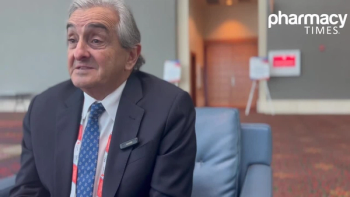
Phase 3 Trial Results Show Metabolic Tumor Volume Improves Prognostication Compared With SPD in Second-Line R/R LBCL
Expert discusses clinical outcomes of the phase 3 ZUMA-7 trial assessing axicabtagene ciloleucel versus standard-of-care in second-line large B-cell lymphoma by metabolic tumor volume.
Pharmacy Times®interviewed Frederick L. Locke, MD, medical oncologist and translational researcher, Department of Blood and Marrow Transplant and Cellular Immunotherapy, Moffitt Cancer Center, on the poster presentation titled “Association of Metabolic Tumor Volume (MTV) and Clinical Outcomes in Second-Line (2L) Relapsed/Refractory (R/R) Large B-Cell Lymphoma (LBCL) Following Axicabtagene Ciloleucel (Axi-Cel) Versus Standard-of-Care (SOC) Therapy in ZUMA-7” at
Pharmacy Times®: What did the phase 3 ZUMA-7 trial show regarding axicabtagene ciloleucel versus standard-of-care therapy in second-line relapsed/refractory large B-cell lymphoma?
Frederick L. Locke: So ZUMA-7 is a phase 3 randomized study of the CAR T-cell therapy axicabtagene ciloleucel, or axi-cel for short, as compared to standard of care in second-line large B-cell lymphoma. In that trial, axi-cel showed superiority to the existing standard of care across common prognostic subgroups, and that includes better event free survival for patients who had elevated lactate dehydrogenase, or LDH. And for those patients that had a high tumor burden larger tumors as calculated by the sum of the product of the diameters, or SPD, which is measured on a CT scan.
Pharmacy Times®: What is the value of measuring tumor burden by metabolic tumor volume, and why was this important to assess in ZUMA-7 trial?
Frederick L. Locke: The sum of the product of diameters, or SPD, is one way to measure tumor burden. And this is done on some lymphoma trials where the CT scans are measured in 2 dimensions, that's up to 6 [of the] largest lesions or target lesions are measured, and then you can add up those products of those 2 dimensions for those 6 lesions and come up with an estimate of the size of tumor for a patient. However, this only counts for this bi-directional measurement. It doesn't account for 3 dimensional tumors, and it doesn't account for metabolic activity. And so because you can have a lymph node that no longer holds lymphoma, and that may be present. And we tease that out by using [fluorodeoxyglucose positron emission tomography-computed tomography (FDG PET-CT)] scans.
So metabolic tumor volume, or MTV, is calculated from an FDG PET scan, and it can be used to measure to a burden. And this measure, MTV, has been shown to correlate with clinical outcomes of CAR T cell therapy in the third line setting for CAR T-cell therapy for relapsed refractory large B cell lymphoma. So we thought this measurement, which is believed to be much more accurate at measuring the volume of tumor, is a better way to quantify the amount of tumor before CAR T-cell therapy, which we believe will be a predictor of response or associated with outcomes. So that's why we wanted to do MTV in the ZUMA-7 clinical trial.
Pharmacy Times®: What did the results show regarding the association between metabolic tumor volume and clinical outcomes in second-line relapsed/refractory large B-cell lymphoma?
Frederick L. Locke: Well, first of all, [MTV] was calculated at baseline for both arms of the study. Some interesting findings, first of all, MTV, did positively correlate to the measurement of tumor burden by the sum of the product of the diameters, but it was only a moderate correlation. There actually, I would say, was a moderate correlation by a Spearman coefficient, but these are not 1 to 1. MTV is clearly picking up patients who have larger tumors, were SPD does not. Similarly for lactate dehydrogenase, or LDH, MTV only moderately correlates. So it's picking up some features that are not found on either these other 2 measures.
What we found is that patients who have higher MTV [that’s] greater than the median MTV have worse outcomes. They have worse event free survival if they're treated with either axi-cel or the standard of care. But what's pretty clear is that even for patients with high MTV, they clearly do better with axi-cel CAR T-cell therapy than if they have high MTV and get the standard of care. So although high MTV is associated with worse outcomes with axi-cel, those patients still did better with better efficacy outcomes than in patients who got the standard of care.
Another interesting thing we found is that patients with severe grade 3 or higher cytokine release syndrome or grade 3 or higher neurologic events, in the axi-cel arm, those patients had higher [MTV] than patients who had lower metabolic tumor volume. So more tumor is associated with more toxicity with CAR T-cell therapy and with the standard of care treatment arm, we didn't see any association with MTV and safety.
Pharmacy Times®: What are the implications of these results for the field?
Frederick L. Locke: To our knowledge, this analysis is the first to examine the relationship between metabolic tumor volume, or MTV, and clinical outcomes in a large randomized prospective clinical trial of CAR T-cell therapy for large B-cell lymphoma.
Similar to other analyses in the third or later line setting, SPD did predict for efficacy and safety outcomes, but regardless, axi-cel was superior to the standard of care for both high and low MTV groups. So, when we looked at SPD, it did not seem to impact outcomes, but MTV clearly shows that the size of tumor matters for outcomes. Really, taken together, these findings suggest that MTV is just a better prognostic marker than the sum of the product diameters as a measurement.
Newsletter
Stay informed on drug updates, treatment guidelines, and pharmacy practice trends—subscribe to Pharmacy Times for weekly clinical insights.


















































































































































































































